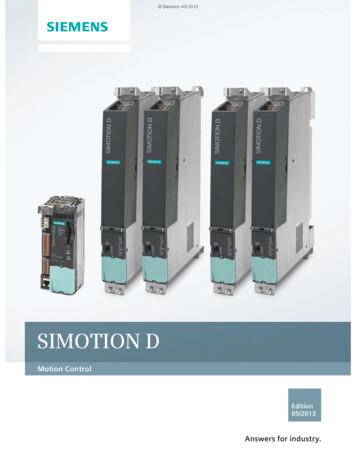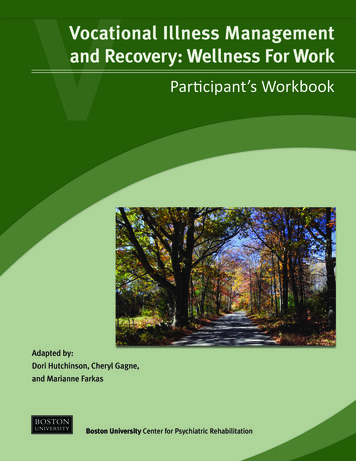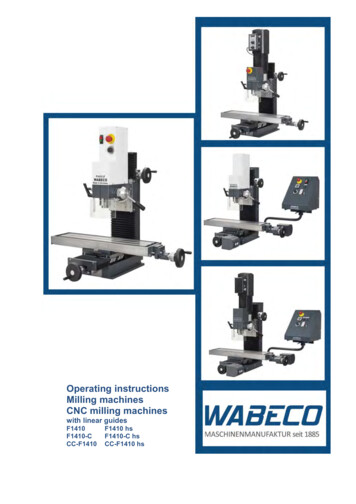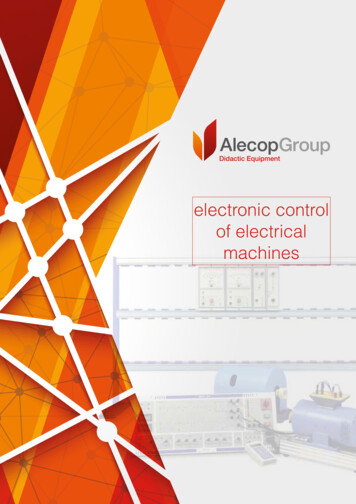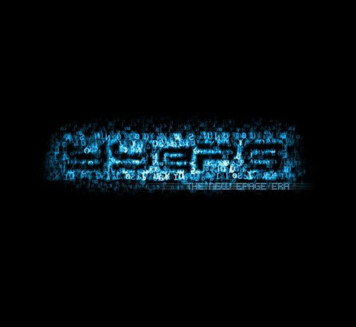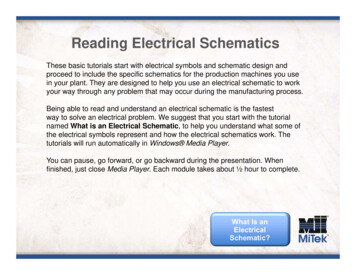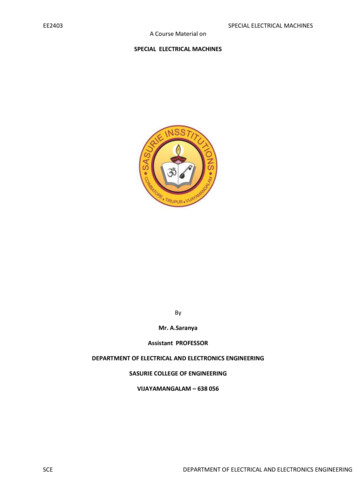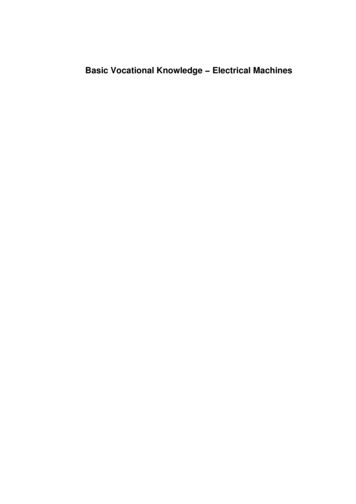
Transcription
Basic Vocational Knowledge Electrical Machines
Table of ContentsBasic Vocational Knowledge Electrical Machines.1Introduction.11. General information about electrical machines.21.1. Definition of terms.21.2. Types of electrical machines.21.3. Operations of electrical machines.21.4. System of rotating electrical machines (generators, motors, converters).31.5. System of stationary electrical machines (transformers).32. Basic principles.42.1. The magnetic field.42.2. Measurable variables of the magnetic field.112.3. Force action of the magnetic field.132.4. Voltage generation through induction.153. Execution of rotating electrical machines.183.1. Size.183.2. Designs.193.3. Degree of protection.213.4. Cooling.223.5. Mode of operation.243.6. Heat resistance categories.263.7. Connection designations of electrical machines.273.8. Rotating electrical machines in rotational sense.283.9. Rating plate.284. Synchronous machines.304.1. Operating principles.304.2. Constructional assembly.344.3. Operational behaviour.364.4. Use of synchronous machines.425. Asynchronous motors.435.1. Constructional assembly.435.2. Operating principles.455.3. Operational behaviour.485.4. Circuit engineering.525.5. Application.705.6. Characteristic values of squirrel cage motors.706. Direct current machines.716.1. Constructional assembly.716.2. Operating principles.736.3. Operational behaviour of direct current machines.806.4. Circuit engineering and operational features of customary direct current generators.846.5. Circuit engineering and operational features of customary direct current motors.877. Single phase alternating current motors.917.1. Single phase asynchronous motors (single phase induction motors).917.2. Three phase asynchronous motor in single phase operation (capacitor motor).967.3. Split pole motors.967.4. Single phase commutator motors (universal motors).978. Transformer.1028.1. Transformer principle.1028.2. Operational behaviour of a transformer.1068.3. Three phase transformer.112i
1. General information about electrical machines1.1. Definition of termsAn electrical machine converts energy from one category into another. Thereby at least one energy categoryfeatures as electric power.Survey 1 Energy transformation of electrical machinesIrrespective of manifold features, for instance the external shapes of the electrical machines, they all comprisetwo electric circuits which have been coupled through a magnetic circuit.An electrical machine is an energy converter in which two electric circuits have been coupled by means of amagnetic circuit.1.2. Types of electrical machinesThe components, namely the bearers of both electric circuits are rigid to one another in stationary electricalmachines. Conversely, the bearers of the electric circuits are mobile to one another in rotating electricalmachines. This explains the system of electrical machines.Survey 2 System of electrical machines1.3. Operations of electrical machinesThe operation of electrical machines results from their incorporation into the process of energy conversion inthe generation, transmission and consumption of electric power. Thus, for example, in a power station thecombustion heat of coal, natural gas, etc. is employed in boilers for steam generation. The energy flow of thesteam drives the turbine which is coupled to a turbine generator that converts the flow energy into electricenergy. The efficient transmission and distribution of electric energy is ensured through the high voltagesgenerated by the transformers. Thereby, the high voltages are switched to consumer voltage and directed to amotor whose mechanical energy drives machines in industry, the home and traffic.2
Survey 3 Tasks of electrical machines in power flow1.4. System of rotating electrical machines (generators, motors, converters)Since the energy direction of an electrical machine is reversible, the rotating electrical machine can operate,without constructional changes, as a motor or generator and transform the stationary electrical machineupwards or downwards. For this reason rotating electrical machines are generally systematized in accordancewith their operating principles.Survey 4 System of rotating electrical machines1.5. System of stationary electrical machines (transformers)Stationary electrical machines (transformers) can be differentiated through manifold features, for exampleaccording to design, coolant, mode of operation, special purpose, etc. Survey 5 features by way of examplethe system of small transformers.3
Survey 5 System of small transformers2. Basic principles2.1. The magnetic field2.1.1. Definition and presentation of the magnetic fieldThe area within which magnetic actions arise is called the magnetic field.Field lines are employed to display graphically magnetic fields. Figure 1 shows a current carrying conductor.Iron powder scattered at the level of this arrangement falls into concentric circles. This leads to a modelpresentation of field lines.Figure 1 Magnetic field and field line sequence made visible by iron powder2.1.2. MagnetsMagnetic fieldBodies of ferromagnetic materials (e.g. iron, nickel, cobalt, etc.) have a magnetic field in their vicinity.4
Figure 2 Magnetic field of a permanent magnetDirection of field linesAs indicated in Figure 2 the field lines emerge from the north pole and enter the south pole. Inside the magnetthe field lines run from the south to the north pole.Magnetic poles always arise pairwise.Magnetic force action law magnets interact with each other.Figure 3 Force actions between magnets (attraction)Figure 4 Force actions between magnets (repulsion) 1 Force actionOpposite poles attract each other, similar poles repel each other.2.1.3. Magnetic field of a current carrying conductorPresentation of the magnetic fieldFigure 5 presents the magnetic field of a current carrying conductor.5
Figure 5 Magnetic field of a current carrying conductor1 Current flow directionStipulations for current presentation Where the current flows away from the viewer, that is to say into the paper plane, a cross isindicated in the conductor cross section. Where the current flows towards the viewer, that is to say out of the paper plane, a dot isentered into the conductor cross section.Figure 6 Current direction designation in the plane of field linesDirection of field linesAs Figure 6 indicates, the direction of the magnetic field lines depends on the current direction. If one viewsthe conductor cross section in current direction, then the field lines appear clockwise.If one clamps such a current carrying conductor with one's fist so that the projecting thumb points in currentdirection, then the bent fingers indicate the direction of the field lines.2.1.4. Magnetic field of a current carrying coilMagnetic polesA coil comprises several conductor loops. The overall magnetic field is derived from the magnetic fields of theindividual conductors.A current carrying coil has both a north and south pole.6
Figure 7 Magnetic field of a current carrying coil(1) Magnetic field of a conductor loop(2) Magnetic field of a coil1 Slant image2 Top view as seen from aboveField directionThe magnetic field lines emerge from the north pole and enter the south pole.If one clamps such a current carrying coil with one's right fist so that the bent fingers point in currentdirection, then the projecting thumb points towards the north pole, (clockhand principle)7
Figure 8 Magnetic field of a coil and clockhand principle(1) Coil(2) Clockhand principle2.1.5. Magnetic fields in electrical machinesField typesEvery rotating machine consists of a stationary section (stand) and a rotating section (rotor).Stands and rotors are made up of magnetic materials and windings and generate magnetic fields in the airgap.We differentiate between the following magnetic fields: constant field alternating field rotating fieldConstant fieldA constant field results from a permanent magnet or through a coil saturated by direct current.Figure 9 Constant field8
(1) Rotor excitation through current flow(2) Stator excitation through current flow1 Field winding, 2 Rotor3 Magnetic flow, 4 StatorA constant field denotes a temporally constant magnetic field in an air gap.Alternating fieldAn alternating field is generated as alternating current passes through a winding.A magnetic field which changes its size and direction according to the frequency is called an alternatingfield.Figure 10 Magnetic alternating field1 Alternating current, 2 Induction and current, 3 Induction sequence, 4 Current sequenceRotating fieldDefinition of term:A rotating field may be compared to the magnetic field of a rotating, permanent magnet.Figure 11 Emergence of a rotating field through rotation of a permanent magnetA rotating field denotes a rotating magnetic field within a specific space.Generating a rotating field:As Figure 12 indicates, the simplest stator of a rotating machine features three spatially positioned coils at 120degrees. These coils are saturated by three temporally displaced three phase currents at 120 degrees.9
Figure 12 Emergence of a rotating field in the stator of a rotating electrical machine(1) Stator with three spatially displaced windings(2) Commensurate temporally shifted currents, t1; t2; t3 Instantaneous timesThe current directions are arbitrarily indicated thus: — Figure 13 indicates each coil with a winding and in its veritable spatial position. A clear cut picture of currentdistribution for the moments t1, t2 and t3 emerges once the current directions in the individual conductors areentered into a line diagram.Figure 13 Explanation for the emergence of a rotating fieldt1; t2; t3 Instantaneous timesFigure 13 indicates clearly that a single magnetic field emerges with a north and south pole following thespatial displacement of the coils (motionless in the area) coupled with a temporal displacement of thecurrents.Speed of the rotating field:A stator winding where the three coils have been so switched as to only yield one north pole and one southpole is called a two pole machine or a machine with a pole pair (p 1). A four pole machine thus has two polepairs etc.10
Figure 14 Four pole machineGiven a two pole machine the rotating field runs once through for every period of the alternating current.Following a period the pole pairs only undertake a half rotation.The speed of the rotating field depends on the frequency of the alternating current and the pole pair:A maximum speed of 3000 rpm can be attained given a frequency of f 50 Hz.2.2. Measurable variables of the magnetic field2.2.1. Magnetomotive forceMagnetic fields are caused by electric currents.Magnetomotive force signifies the existence of a magnetic field if the current flows through a conductor loop.Figure 15 Stationary induction(1) Current carrying conductor loop(2) Current carrying coil1 Current flow direction11
The current "magnetomotives" the enclosed magnetic field lines. The magnetomotive force can be increasedif the same current is conducted several times through the field lines (Cp. Fig. 15).This applies for a current carrying coil with a number of turns equalling N: I·NFormula signUnit (Theta)[] 1 A2.2.2. Magnetic flowMagnetic flow denotes the total number of field lines of a I current carrying coil or a magnet.Formula sign ?Unit weber(?) V · s 1 volt second2.2.3. Magnetic flow densityMagnetic flow density denotes the magnetic flow which permeates a certain surface in a vertical direction.Figure 16 Definition of magnetic flow density1 Surface element, e.g. 1 cm2A uniform magnetic field is:12
Formula sign BUnit tesla2.3. Force action of the magnetic field2.3.1. Force action on current carrying conductorsOperating principleA current carrying conductor is enclosed by a magnetic field, If this conductor is entered into a magnetic field,the individual fields are superimposed.Figure 17 Force actions of current carrying conductors in the magnetic field(1) Basic presentation of the superimposing fields(2) Force action of the superimposed fields1 Force directionOn the one hand there is magnetic flow boosting. Conversely, one encounters magnetic flow fading.A current carrying conductor is pushed away from the external magnetic field towards the weaker field side.Left hand rule (motor rule)If the left hand is positioned thus in a magnetic field so that the field lines enter the palm of the hand and theprojected four fingers are directed towards the conductor current, then the extended thumb points in forcedirection towards the conductor.13
Figure 18 Left hand rule (motor rule)1 Current direction in conductor2 Direction of the magnetic field3 Direction of movementElectrodynamic law of forceForce is yielded through the following equation:F B·1·I·NF forceB magnetic flow density of the external magnetic fieldI current in the conductor1 conductor length in the magnetic fieldN number of conductors in series circuit (coils)2.3.2. Force action on current carrying coils (motor principle)Motor principleAs opposed to Figure 17, Figure 19 features a conductor loop is positioned in a rotatable manner. A force isexerted on both conductor sides. This yields an overall torque.M 2·F·rFigure 19 Torque incidence in a conductor loop1 Radius, 2 Effective length3 Current direction, 4 Force actionMotor equationThe following equation is forthcoming from the electrodynamic law of force14
M 2·B·l·I·N·rM c·?·Ic machine constants (constructive values) magnetic flow of the external magnetic fieldI current in the conductor loop or coil2.4. Voltage generation through induction2.4.1. General law of inductionA voltage is induced where a circuit is saturated through a temporally altering magnetic flow.2.4.2. Stationary induction (transformer principle)Given stationary induction (Figure 15), the magnetic flow alteration is generated by means of a stationaryconductor loop or coil and a temporally changeable magnetic flow.2.4.3. Motional induction (generator principle)Operating principleGiven motional induction a change in the magnetic flow is attained through the movement of magnets, equallythrough the motion of an electric conductor within a magnetic field.Figure 20 Induction through magnetic flow change (movement of a magnet)1 Induced current, 2 Direction of movement15
Figure 21 Induction through magnetic flow change (movement of a conductor)1 Induced current2 Direction of movementThe following applies to several series switched conductors (coils):Uo N.B.l.vUo general voltage of a motional conductor in a magnetic fieldBmagnetic flow density of a magnetic fieldlconductor length in the magnetic fieldvmotional speed of the conductorNnumber of series switched conductorsRight hand rule (generator rule)If the right hand is so positioned in a magnetic field that the field lines enter the open palm of the hand and theprojected thumb points in the motional direction of the conductor, then the extended four fingers point in thedirection of the current in the conductor loop forthcoming through the generated voltage.Figure 22 Right hand rule (generator rule)1 Direction of the magnetic field2 Direction of the induction current3 Direction of movement16
An example is indicated in Figure 23.Figure 23 Rotating movement of a conductor loop in the magnetic fieldGenerator equationThe following equation results from applying the induction law:with v ? · d · nUo c · ? · nc machine constant (constructive values)n speed of the conductor loopQuestions for repetition and control1. What causes a magnetic field?2. How is a magnetic field presented?3. How are field line direction and current direction related to one another?17
4. What are the differences between a magnetic constant field and an alternating field?5. How is a rotating field generated?6. What does the speed of the rotating field depend on?7. What is meant by magnetomotive force?8. How are magnetic flow and magnetic flow density interrelated?9. How are the forces directed which similar and opposite magnetic poles exert to one another?10. Describe the left hand rule.11. Which values exert an influence on the torque of a motor?12. Describe the right hand rule.13. Which values are of decisive importance for the induced voltage in a generator?3. Execution of rotating electrical machines3.1. SizeFigure 24 shows the standard dimensions of rotating electrical machines.Figure 24 Normed dimensions of rotating electrical machines1 Shaft and length (drive shaft), 2 Distance between shaft and clearance hole, 3 Distance ofclearance holes (longitudinal) 1 Distance of clearance holes (end shield), 5 Distance ofclearance holes (transverse), 6 Diameter (clearance holes), 7 Height to shaft centre, 8 TotalheightIn order to guarantee interchangeability of various machines the "International Electrotechnic Commission"(EEC) has established a uniform norm for sizes which are designated by figures ranging from 56 to 400. Thecited numerals simultaneously indicate the axle height of the respective machines.Survey 6 Dimensionshmm18
5663718090100 112 132 16018200 225 250 280 315 355 4003.2. Designs3.2.1. DefinitionIt must be possible to set up the machine as a unit resp. prime mover. This presupposes differing externalconstructions in order, thereby, to facilitate a coupling between electrical machine, work units or prime mover.Figure 25 Designs(1) Foot machine with end shield(2) Machine without feet with end shield flangeWe comprehend design as the arrangement of machine elements in regard of holding elements, theposition of bearings and shaft ends.3.2.2. DesignationDesigns are given code letters "IM" in the same manner as degrees of protection and coolants. The lettersalso indicate the design group, assembly variety and shaft end execution.19
Survey 7 Design category explanations (first figure)1 Foot machine with end shields2 Foot machines with end shields and end shield flange3 Machines without feet with end shields and flange on one shield4 Machines without feet with end shields, with casing flange5 Machines without bearings6 Machines with end shields and pillow blocks7 Machines with pillow blocks (without and shields)8 Vertical machines which are not covered by the categories IM 1 to IM 49 Specially constructed machines according to assembly typeSurvey 8 Shaft end type of rotating electrical machines (fourth figure)0 Without shaft end1 With a cylindrical shaft end2 With two cylindrical shaft ends3 With a conical shaft end4 With two conical shaft ends5 With a flange shaft end6 With two flange shaft ends7 With flange shaft end on the D side and cylindrical shaft end on the N side8 All other types with shaft ends.The most common design groups are IM 1001 and IM 3001.The assembly variety is indicated through two numbers. Assembly variety relates to the erection site of themachine regarding the shaft axle and holding elements.20
Survey 9 Frequent design categories3.3. Degree of protection3.3.1. DefinitionA machine must be protected from penetration of foreign bodies and water. Indeed, this is essential forensuring disturbance free operation. Contact protection provisions are also necessary in the interests oflabour safety.Degree of protection denotes a designation indicating how a rotating machine is protected from penetrationof water and foreign bodies and how human beings are prevented from coming into contact with electricalconductors and rotating parts.3.3.2. DesignationAn abbreviation has been adopted for designating the degree of protection:The abbreviation features:The arrangement of the numerals for contact and foreign body protection along with the numerals pertainingto water protection have been set out in Survey 10.Survey 10 Protection grade characteristics1. Figure (shock andforeign matterprotection)0 unprotected212. Figure (water protection)0 unprotected
1 protection from1 drip proofforeign matter2 inclined up to 15 degreesgreater than 50 mm3 rain protection2 greater than 12 mm4 splash proof3 greater than 2.5 mm5 hose proof4 greater than 1.0 mm6 splash proof5 dust protection7 pressurized water proof8 permanent pressurized water proofSurvey 11 features the degree of protection.Survey 11 Degree of protection of rotating electrical machinesFirst figure (shock and foreign matter protection)Second figure (water protection)01234560IP 00IP 01 1IP 10IP 11IP 12IP 13 2IP 20IP 21IP 22IP 23 3 4 IP 43IP 44 5 IP 54IP 55IP 566 3.4. Cooling3.4.1. Cooling categoryUndesired heat development results from the joule heat in the windings. The winding insulation can bedamaged and the machine destroyed if the permissible conductor temperature is exceeded. Consequently,adequate heat dissipation facilities must be provided.Cooling category signifies the manner in which heat is dissipated.We differentiate between the following cooling categories:self cooling:The machine is cooled through air motion and radiation without resorting to aventilator.natural cooling:The cooling air for the machine stems from a ventilator attached to the rotor.separate cooling:The machine is either cooled through a ventilator which is not driven by themachine shaft or, alternatively, by means of another separately movedcoolant instead of air.22
3.4.2. Cooling category designationThe coolant category designation indicates:Type of coolantNature of the cooling cycleMethod of the coolant circulationDesignation:1. Code letters of the cooling IC2. Type of coolantGasesairAhydrogenHnitrogenNcarbon dioxideCLiquids wateroilWU(Where air only is used for cooling the letter "A" can be dropped.)3. Cooling cycle arrangement (1st index)4. Method of coolant circulation (2nd index)Coolant designation pattern:Examples:IC01air cooled machine, free cycle, self cycle coolingIC0141air cooled machine, two cooling cycles, primary coolant dissipates its heat from the casingsurface (4); the primary coolant is in self cycle (1) whilst the coolant circulates freely (0)coupled with self circulating coolant effects (1)ICA01H41 Primary coolant is hydrogen; the heat is led off from the casing surface, the hydrogen featuresa self cycle; air is used as secondary coolant; the air circulates freely during self cooling.The openings through which the air enters must remain uncovered. Improper machine erection resp. anyobstruction of cooling air passage paves the way for both heat damage and possible emission throughsoilage. Consequently, all machine cooling devices must be regularly serviced.23
3.5. Mode of operation3.5.1. DefinitionOperating an electric motor always gives rise to undesirable energy conversion. This in turn leads to heatingup which, above all, strains the winding insulations. The service life of a machine is decisively influenced by itsinside temperature. Thermal overloading can engender operational disturbances. Estimates indicate that atemperature increase of 8K reduces machine life by 50 per cent. Heating up results first and foremost throughenergy passage in the windings. The designation W I2 · R · t shows that the conversion into heat and therelated temperature rise are determined by the current flow and its duration. Temporary overloading ispermissible as, due to thermal inertia, the temperature increase remains insignificant. A torque increase forthe work unit, respectively a mass inertia when starting or braking give rise to greater losses in the motorthrough the flow of higher starting or braking currents. Load, starting and braking thus exert an influence onthe degree of heating up. Consequently, for reasons related to thermal load, electric motors must be alignedto the load rhythm of the work unit.Mode of operation relates to the nature and sequence pattern, equally the duration of standstill and idlingtimes, also to the nominal load of electrical machines.3.5.2. Operational mode designationFollowing abbreviations have been stipulated:S1 permanent operationS2 short term operationS3 intermittent operation with starting or braking influencesS4 intermittent operation with starting influence on temperatureS5 intermittent operation with starting and electric braking influence on the temperatureS6 continuous operation with intermittent loadingS7 uninterrupted operation with starting and electric brakingS8 uninterrupted operation at differing speeds3.5.3. Frequent nominal cycle ratingsOperational mode S1Nominal load machine running continues (tB) until machine heating up has attained its final temperature whichdoes not increase further.Figure 26 Rated operating type S124
Legend as for Figure 28The final temperature shall not exceed the limit temperature heat resistance category of the machine.Operational mode S2Nominal load machine running continues until the limit temperature of the machine has been attained. Thenthere is a break which lasts until the machine temperature has attained room temperature. The desired valuesof 10, 30, 60 and 90 minutes apply for the duration of short time operation.Figure 27 Rated operating type S2Legend as for Figure 28Operational mode S3The machine runs in periodical operation in a permanent sequence of like cycles (tSP). Each cycle includesnominal load operation and a break (tp) with standstill time whereby the startin
upwards or downwards. For this reason rotating electrical machines are generally systematized in accordance with their operating principles. Survey 4 System of rotating electrical machines 1.5. System of stationary electrical machines (transformers) Stationary electrical machines (transformers
